August 19, 2013
by Carole Zangari -
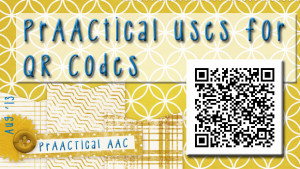
In some of our posts, we talked about using QR (Quick Response) codes as a way to share information. If you are new to QR codes, they are like bar codes in that you scan them with some kind of device (like a smart phone or tablet) that has software or an app that reads the code. Then what? Then it takes you to whatever the author wanted you to see or hear. For example, a QR code on an SGD in a loan library might take you to a quick start tutorial on the manufacturer’s website. A QR code on a handout might take you an electronic copy of that handout that is stored on someone’s website or a cloud service, like DropBox or Google Docs/Drive. A QR code on the student’s picture card ring might take you to an audio recording of directions for how to complete a... [Read More...]
Filed under: PrAACtical Thinking
Tagged With: QR codes
August 16, 2013
by Robin Parker -
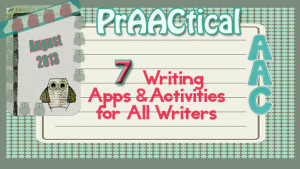
These are some ‘non-traditional’ but really fun apps and activities that can be used to help improve writing, choice making, & AAC skills for all levels of writers. These apps allow you to create meaningful language experiences through the process of creating the written documents, by talking about & printing out the finished product, as well as by using writing specific reinforcement so that the learner knows they are really a writer (“wow, you are an author”, “great writing”, “awesome using many different words”, “excellent poetry”, etc.). Have fun and write. Type Drawing– TypeDrawing allows you to enter text or choose from a text word bank to draw lines or pictures. The text is repeated each time you begin drawing or touch and drag on the screen with your finger. We used this to make text pictures and then sent the pictures as notes to friends, birthday cards to a... [Read More...]
Filed under: PrAACtical Thinking
Tagged With: activities, Apps, resources, writing
August 15, 2013
by Carole Zangari -
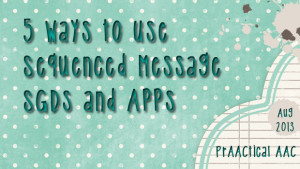
We’ve been having fun with sequenced message communicators and apps this summer. Yes, they’ve been around for a long time, but that doesn’t mean we use them to capacity. You just can’t beat those simple technologies for flexibility and ease of use. Here are some of the things we’ve been trying out. 1. Say hello: Record a variety of age appropriate greetings so that each time the AAC learner uses it, they greet their peers in different ways (e.g., Teen: “What’s up? Hey, how’s it going? Lookin’ good! Nice to see ya! Hey, what’s goin’ on?”). 2. Get the group’s attention: Allow AAC learners to help get their classmates’ attention (e.g., “Listen up, everyone! Mrs. Martinez has something to say”. “Hey, room 113-Mrs. M is ready for us to move on.” “Eyes forward, room 113.”). 3. Give instructions: Record steps to an activity so that the AAC learner can give... [Read More...]
Filed under: PrAACtical Thinking
Tagged With: 5, five, sequenced message, SGD
August 14, 2013
by Robin Parker -
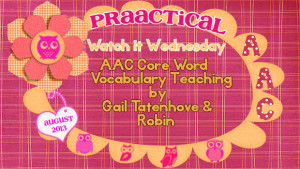
Thanks so much to Gail Tatenhove & Robin for showing us an authentic language based activity with talking and core word teaching/learning as the main focus. You can watch and clearly see the goals and teaching strategies. For more great teaching examples, subscribe to Gail Tatenhove’s You-Tube Channel Direct Link to the Video: https://www.youtube.com/watch?v=q9hZ5rH03ow
Filed under: PrAACtical Thinking
Tagged With: aided language input, by Gail tatenho, examples, teaching
August 13, 2013
by Robin Parker -
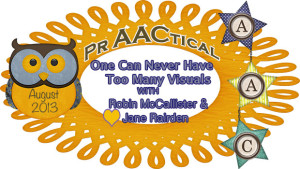
Today, we are so excited to have our new friends from the awesome blog lunchbuddiesplus sharing how and why they incorporate visual supports into their sessions. In their lunchbuddiesplus group sessions, the focus is on social skills and they find that visual supports make a huge positive impact. So as you get ready for back to school, think about the visual supports that will help make your goals and activities go smoothly. Robin McCallister is a Speech/Language Pathologist working at Mary Munford Elementary School in the Richmond City School district in Richmond, Va. She has 36 years of experience in the public schools. Currently, she spends most of the school day working withchildrenwho experience autism. She especially enjoys the social skills groups known at Mary Munford as “lunch buddies”. Visuals are a big part of social skills coaching and Robin knows that one can never have too many visuals! You are invited... [Read More...]
Filed under: PrAACtical Thinking
Tagged With: emotional regulation, guest blogger, lunch buddies, visual supports
August 12, 2013
by Carole Zangari -

Looking for ways to engage older learners with age appropriate materials? Searching for fresh ideas for AAC and language practice? Tellagami (“tell-uh-gah-mee”) is a free iOS app that allows you to create short animations, save them to your device, post to Facebook, and share them by email, SMS text, or Twitter. Best part about it, in this busy SLP’s opinion? Super easy to learn and use! The animations are called ‘Gami’s’ and are short and fun to make. The app has a good amount of flexibility and you are only limited by your imagination. Here are some ideas for putting it to use in your AAC work. 1. Choice making: The AAC learner can work collaboratively with a peer to create a Gami. In doing so, he/she can make selections of things like the gender of the character, hair, clothes, and the background. 2. Peer interactions: Many of our AAC... [Read More...]
Filed under: PrAACtical Thinking
Tagged With: Apps, choicemaking, family, Magic Moments, narratives, Tellagami
August 9, 2013
by Robin Parker -
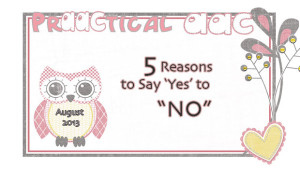
We had a ‘situation’ yesterday which really was sign of progress and not a ‘situation’ at all. We know a young adult who is non-verbal and communicates primarily with an object communication system. He is typically happy and at the very least passive. Usually this learner will participate in any activity even if he does not like it. He will follow the sequence, follow instructions, and do what is expected but with minimal communication if it is an undesired activity. Of course, we try to do things he likes, but sometimes it is not so clear, it can change, or it just may be too much of a good thing. Back to the story….we had a special session planned with many of his favorite things. Awesome things, things we had been waiting to do with him. We even had a special guest who had special things. However, when we started... [Read More...]
Filed under: PrAACtical Thinking
Tagged With: communication, protesting
August 8, 2013
by Carole Zangari -
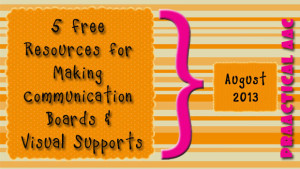
Because sometimes you need something quick, simple, and free. 1. Quick Pics from the Patrick Ecker AAC site 2. ConnectAbility’s Visual Engine 3. Picto4Me: An app for your computer that you can install to Chrome 4. PhotoSYMS program 5. Aragonese Portal of AAC: Over 14,500 symbols that you can download and use
Filed under: PrAACtical Thinking
Tagged With: 5, communication book, five, free, resources, visual support
August 7, 2013
by Robin Parker -
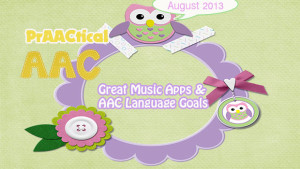
We love music, we love apps, we love great language opportunities and with these apps we can combine all these loves. These awesome music apps were selected because they have great choice making and commenting opportunities. You can use no tech, low tech, or an extra high-tech device to make choices and comment while you play with the app. Core words work great for choice making and commenting. Whenever I play or sing, my kids love to say “stop that” or “don’t do that pleeeeease”. When they play, I love to use aided language input (ALI) to say “good”, “more”, “again”, “love it” . We play the music “fast” and “slow”. We “find” our “favorite one”. We all like to say “let’s play with that one” or “let’s do it together”. The possibilities are really endless (and that is one of the reasons we love core words). These apps sound... [Read More...]
Filed under: PrAACtical Thinking
Tagged With: aided language input, Apps, language goals, music
August 6, 2013
by Robin Parker -

We had some great experiences this week with some awesome client’s and their families. We were reminded of this very effective language facilitation strategy: And if you need some ideas for waiting, check out 10 ways to practice waiting… for language. Waiting works best when you wait with eye brows raised (expectantly) and then if needed use a gestural cue towards the communication display and if more cueing is needed point to a more specific communication display cell(cells) as options. By then, you will probably get a self-initiated communication message. If not, model & honor the inferred intent and find another communication opportunity and wait…..
Filed under: PrAACtical Thinking
Tagged With: communication opportunity, Language facilitation strategies, wait and signal









